
Sapphire is a precious gemstone, a variety of the mineral corundum, consisting of aluminium oxide (α-Al2O3) with trace amounts of elements such as iron, titanium, chromium, vanadium, or magnesium. The name sapphire is derived via the Latin "sapphirus" from the Greek "sappheiros", which referred to lapis lazuli. It is typically blue, but natural "fancy" sapphires also occur in yellow, purple, orange, and green colors; "parti sapphires" show two or more colors. Red corundum stones also occur, but are called rubies rather than sapphires. Pink-colored corundum may be classified either as ruby or sapphire depending on locale. Commonly, natural sapphires are cut and polished into gemstones and worn in jewelry. They also may be created synthetically in laboratories for industrial or decorative purposes in large crystal boules. Because of the remarkable hardness of sapphires – 9 on the Mohs scale (the third hardest mineral, after diamond at 10 and moissanite at 9.5) – sapphires are also used in some non-ornamental applications, such as infrared optical components, high-durability windows, wristwatch crystals and movement bearings, and very thin electronic wafers, which are used as the insulating substrates of special-purpose solid-state electronics such as integrated circuits and GaN-based blue LEDs. Sapphire is the birthstone for September and the gem of the 45th anniversary. A sapphire jubilee occurs after 65 years.

The Hope Diamond is a 45.52-carat (9.104 g) diamond originally extracted in the 17th century from the Kollur Mine in Guntur, India. It is blue in color due to trace amounts of boron. Its exceptional size has revealed new information about the formation of diamonds.

Crater of Diamonds State Park is a 911-acre (369 ha) Arkansas state park in Pike County, Arkansas, in the United States. The park features a 37.5-acre plowed field, the world's only diamond-bearing site accessible to the public. Diamonds have continuously been discovered in the field since 1906, including the graded-perfect Strawn-Wagner Diamond, found in 1990, and the Uncle Sam, found in 1924, which at over 40 carats is the largest diamond ever found in the United States.

The Argyle Diamond Mine was a diamond mine located in the East Kimberley region in the remote north of Western Australia. Argyle was at times the largest diamond producer in the world by volume, although the proportion of gem-quality diamonds was low. It was the only known significant source of pink and red diamonds, and additionally provided a large proportion of other naturally coloured diamonds, including champagne, cognac and rare blue diamonds.
The De Beers Centenary Diamond is, at 273.85 carats (54.770 g), the third-largest diamond to have been produced in the Premier Mine. Among top-color diamonds, only the Cullinan I and II are larger than the Centenary diamond. The Centenary Diamond is rated in color as grade D color by the Gemological Institute of America, which is the highest grade of colourless diamond and is internally and externally flawless. It was named the Centenary Diamond as it was presented in the rough for the Centennial Celebration of De Beers Consolidated Mines on 11 May 1988. The Centenary Diamond was unveiled in final form in May 1991.

Harry Winston was an American jeweler. He donated the Hope Diamond to the Smithsonian Institution in 1958 after owning it for a decade. He also traded the Portuguese Diamond to the Smithsonian in 1963 in exchange for 3,800 carats of small diamonds.
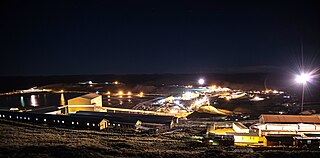
The Letšeng Diamond Mine, found in the landlocked Southern African kingdom of Lesotho, is owned by Gem Diamonds, Ltd. and the government of Lesotho, and at an elevation of 3,100 m (10,000 ft) it is the world's highest diamond mine.
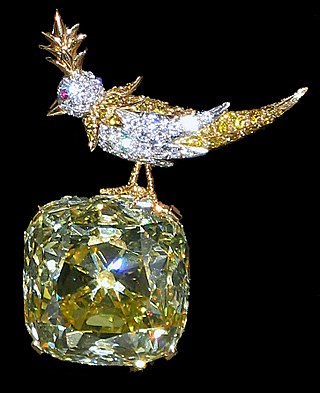
The Tiffany Yellow Diamond is one of the largest yellow diamonds ever discovered. Its carat weight was originally 287.42 carats in the rough when discovered in 1878 in the Kimberley mine in South Africa. It was cut into a cushion shape of 128.54 carats with 82 facets—24 more than a traditional round brilliant—to maximize its brilliance. The facet pattern features eight needle-like facets pointing outward from the culet (bottom) facet. Jewelry and diamond historian Herbert Tillander refers to this as a "stellar brilliant cut", and lists the gem in his book, Diamond Cuts in Historic Jewelry – 1381 to 1910 (1995), among other such diamonds: the Cullinan Diamond, the Koh-i-Noor, the Polar Star, the Wittelsbach, and others.
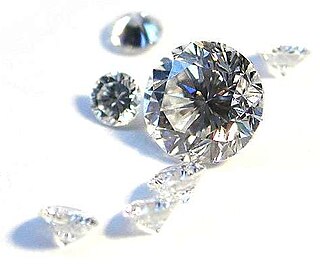
Diamond is one of the best-known and most sought-after gemstones. They have been used as decorative items since ancient times.
The Amarillo Starlight is the largest diamond found by a park visitor in the Crater of Diamonds State Park in Arkansas since 1972, when it was established as a state park. The Amarillo Starlight was found by W. W. Johnson of Amarillo, Texas in 1975 while he was vacationing at the park with his family. When unearthed, it was a 16.37 carats (3.274 g) white diamond, but it has since been cut into a 7.54 carats (1.508 g) marquise shape. Its value has been estimated between $150,000 and $175,000.

Petra Diamonds Ltd is a diamond mining group headquartered in Jersey. Petra own one of the world's most productive mines historically, the Cullinan Diamond Mine is famed for having produced the world's largest rough and polished diamond. The company is listed on the London Stock Exchange.
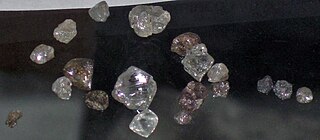
Kelsey Lake Diamond Mine is a defunct diamond mine in Colorado, USA. It is located in the State Line Kimberlite District, near the Wyoming border, and consists of nine kimberlite volcanic pipes, of which two were open pit mined.

The Golden Eye Diamond is a flawless 43.51-carat (8.702 g) Fancy Intense Yellow diamond, claimed by one of its past owners to be the world's largest of its cut and color. It is believed to come from the Kimberley area of South Africa. Tom Moses, a senior vice president with the Gemological Institute of America, agrees that it came from South Africa, but it has not been able to be determined the mine of origin.
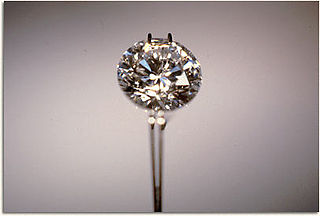
The Strawn-Wagner Diamond is one of a relatively few colorless, internally flawless diamonds found so far in the world, weighing 3.03 carat. It was found in 1990 by Shirley Strawn of Murfreesboro, Arkansas, in the Crater of Diamonds State Park public search field. It was cut to 1.09 carats in 1997, and graded a "perfect" 0/0/0 by the American Gem Society (AGS) in 1998 and graded perfect by the Gemological Institute of America, making it the first diamond from Arkansas to receive such an AGS grading. The diamond is considered one-in-a-billion, according to Peter Yantzer, the AGS Laboratory Director.
Graff is a British multinational jeweller based in London. It was founded by British jeweller Laurence Graff in 1960. A vertically integrated company, Graff operations comprise the design, manufacture and retail distribution of jewellery and watches.

Lesedi La Rona, formerly known in media as Karowe AK6 or as Quad 1 by the personnel at the mine, is the fourth-largest diamond ever found, and the third-largest of gem quality. It was found in the Karowe mine, in Botswana on 16 November 2015.

Pink diamond is a type of diamond that has pink color. The source of their pink color is greatly debated in the gemological world but it is most commonly attributed to plastic deformation that these diamonds undergo during their formation.

The Canary Diamond is an uncut canary-yellow 17.86 carat diamond found in 1917 at what is now Crater of Diamonds State Park in Arkansas. It is in the collection of the Smithsonian Museum of Natural History. The diamond was in the collection of civil engineer and mineral collector Washington Roebling; his son donated it, along with the rest of Roebling's collection, to the museum in 1926 after Roebling's death.

Morganite is an orange or pink variety of beryl and is also a gemstone. Morganite is mined in Brazil, Afghanistan, Mozambique, Namibia, the United States, and Madagascar.
















